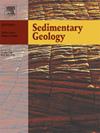冰下砾岩作为冰盖基础条件的敏感记录——以波兰东部为例
IF 2.9
2区 地球科学
Q1 GEOLOGY
引用次数: 0
摘要
本研究报告了一个独特的例子,在波兰东部发现了一个异常致密和坚硬的钙化砾岩,我们指出了冰下形成条件。为了推断其起源,我们采用了宏观和微观研究(实地考察,薄切片分析),并确定了碳酸盐胶结物的同位素组成。砾岩的厚度从几厘米到70厘米不等,发生在MIS6时代的沉积物和下面的冰川河流沉积物之间。它的形成归因于冰盖在冰川边缘扇内的冰川构造变形和永久冻土影响的冰川河流沉积物上的推进。这些冰冻沉积物形成了阻碍冰运动的超大规模障碍物(褶皱和木筏),导致冰下水压增加,并在冰盖底部形成了一层薄薄的水膜。所研究的砾岩为重建活动冰盖下的冰下条件提供了宝贵的资料,其特征如下:(1)地面障碍物冰下背风侧方解石降水;(2)以矿物颗粒周围的连续胶结物和缺乏颗粒间接触为证据的潜水条件下的降水;(3)由空间型和上覆型泥晶胶结层组成的二元结构;冰下开放排水条件下形成疏晶石,封闭排水条件下形成泥晶薄层;(4)碳氧同位素组成证实了闪晶后泥晶的顺序沉淀。钙化砾岩形成于冰原前缘向永冻层覆盖的基底推进的过程中,迄今为止还没有在文献中描述过。本文章由计算机程序翻译,如有差异,请以英文原文为准。
Subglacial conglomerate as a sensitive recorder of the ice-sheet base conditions – An example from eastern Poland
This study reports a unique example of an exceptionally compact and hard calcified conglomerate identified in eastern Poland for which we indicate a subglacial formation conditions. To infer its origin, we employed macro- and micro- studies (fieldwork, thin-section analysis), and determined the isotopic composition of the carbonate cements. The conglomerate, ranging in thickness from a few cm up to 70 cm, occurs between the MIS6 age till and underlying glaciofluvial deposits. Its formation is attributed to the advance of an ice sheet over glaciotectonically deformed and permafrost-affected glaciofluvial deposits within a glaciomarginal fan. These frozen deposits formed mega-scale obstacles (folds and rafts) that impeded ice movement, leading to increased subglacial water pressure and the development of a thin water film at the ice-sheet base. The studied conglomerate represents a valuable archive for reconstructing subglacial conditions under active ice sheet, as evidenced by the following features: (1) calcite precipitation on the down-glacial (lee) sides of the ground obstacles; (2) precipitation in phreatic conditions as evidence by continuous cements around mineral grains and the lacking grain-to-grain contact; (3) bipartite structure comprising sparitic and overlaying micritic cement layers; sparite formed under open-drainage subglacial conditions, whereas micritic thin layer developed during the final stage of water film freezing under closed-system; (4) carbon and oxygen isotope compositions confirming the sequential precipitation of sparite followed by micrite. Calcified conglomerates formed during the advance of the ice sheet front onto the substrate covered by permafrost, have not been described in the literature so far.
求助全文
通过发布文献求助,成功后即可免费获取论文全文。
去求助
来源期刊

Sedimentary Geology
地学-地质学
CiteScore
5.10
自引率
7.10%
发文量
133
审稿时长
32 days
期刊介绍:
Sedimentary Geology is a journal that rapidly publishes high quality, original research and review papers that cover all aspects of sediments and sedimentary rocks at all spatial and temporal scales. Submitted papers must make a significant contribution to the field of study and must place the research in a broad context, so that it is of interest to the diverse, international readership of the journal. Papers that are largely descriptive in nature, of limited scope or local geographical significance, or based on limited data will not be considered for publication.
 求助内容:
求助内容: 应助结果提醒方式:
应助结果提醒方式:


